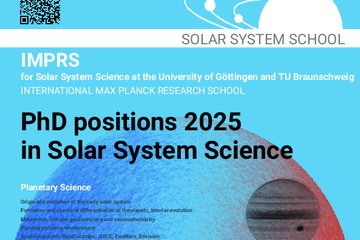All genres
21.
Book Chapter
Type II interplanetary radio bursts and electron plasma oscillations associated with interplanetary shocks, superthermal electrons, and low/medium energy protons. In: Proceedings of the Second International Workshop on the Relation Between Laboratory and Space Plasmas, Tokyo, Japan, November 25-26, 1986, pp. 415 - 421 (Ed. Kikuchi, H.). Springer-Verlag, Berlin (1988)
22.
Conference Paper
SUMER: Temperatures, densities, and velocities in the outer solar atmosphere. In: Proceedings of the First SOHO Workshop, Annapolis, Maryland, USA, 25-28 August 1992, pp. 13 - 16. ESA Publ. Div., Noordwijk (1992)
23.
Conference Paper
SUMER - Solar Ultraviolet Measurements of Emitted Radiation. In: Proceedings of Satellite Symposium 3, München, Germany, 30 March - 4 April 1992, pp. 225 - 226. (1992)
24.
Conference Paper
SUMER - Solar Ultraviolet Measurements of Emitted Radiation. In: Solar Wind Seven, pp. 129 - 130 (Eds. Marsch, E.; Schwenn, R.). Pergamon Press, Oxford (1992)
25.
Conference Paper
Energetic particle phenomena recorded by the SLED instrument during the Phobos mission to Mars. In: 21st International Cosmic Ray Conference, Adelaide, Australia, 6-19 January 1990, pp. 54 - 57. (1990)
26.
Conference Paper
Measurement of electron and ion fluxes near Mars by the SLED instrument on Phobos-2. In: 21st International Cosmic Ray Conference, Adelaide, Australia, 6-19 January 1990, pp. 50 - 53. (1990)
27.
Conference Paper
Review of Interplanetary Shock Phenomena near and within 1 AU. In: Collisionless Shocks in the Heliosphere: Reviews of Current Research, pp. 33 - 50 (Eds. Tsurutani, B. T.; Stone, R. G.). American Geophysical Union, Washington, DC, U. S. A. (1985)
28.
Conference Paper
Acceleration of gt;= 80 keV ions by interplanetary shocks between 0.3-1 AU observed by Helios-1/2: A survey. In: Proc. 16th International Cosmic Ray Conference, Kyoto, Japan, p. 312. (1979)
29.
Conference Paper
Energetic particles at interplanetary shock waves: the April 29, 1978 event. In: Proc. 16th International Cosmic Ray Conference, Kyoto, Japan, pp. 312 - 317. (1979)
30.
Report
Nature and origin of corotating shock waves within 1 AU. Max-Planck-Institut für Aeronomie, Lindau (1980)











